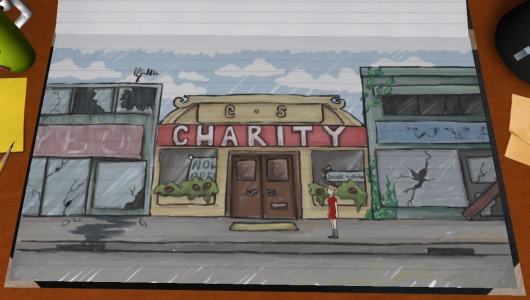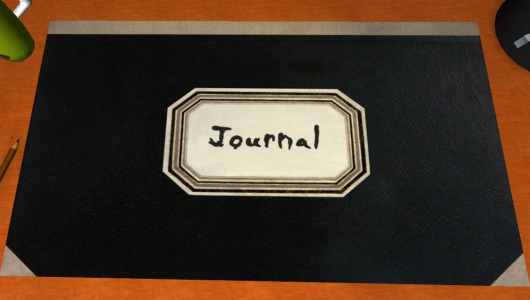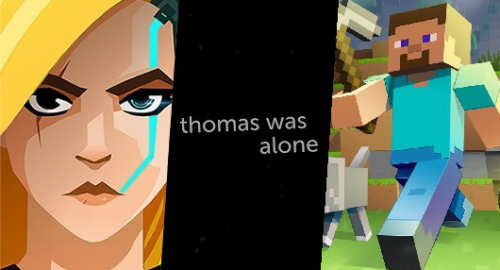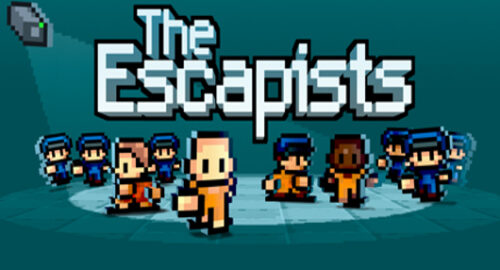Locked Door Puzzle is a game development studio taking tentative steps from the innovations of one man – Richard Perrin. With only three members, this studio of friends seems invested in creating games of “personal expression”, ones that offer experiences that are very real and very human.
• Developer: Locked Door Puzzle
• Publisher: Lupus Studios Limited
• Reviewed on: PC
• Also Available On: Mac & Linux
• Release Date: Available Now

The initially pensive tone of Journal is matched by similarly insightful and personal posts from Richard Perrin on the company’s website, expressing the weightiness his work has entailed and the difficulties he has met in pursuing this ideology of evoking deep emotions within his games. He reveals the struggle that was undertaken in the development of Journal, a game that’s been on and off since 2008. It focuses on the story of a young girl who is seeking to refill the pages of her journal, which have mysteriously become blank. Starting from 8th October, 1977 you control a hand-drawn character – our protagonist and journal owner – who physically walks across these pages as they display different scenes from her life that the player must unravel into meaning.
Much of the gameplay can only be described as plodding – it requires some persevering. Whilst the game is only three hours long, a large portion of it is taken up by to-ing and fro-ing from person to person – the mother, the park-keeper, and a rather morose school friend are examples – and engaging in dialogue. There are dialogue options in parts, although it seems to have little impact of anything – only in how you wish to come across. This provides some connection with our faceless character, some personalisation of how you would deal with the problems she comes across, such as parental disputes and falling out with friends. Unfortunately a lot of the conversations and issues seems slightly trivial, with the gameplay not offering much of a fun factor. The idea of there being more than meets the eye thus rescues Journal from initially appearing slightly meaningless; and there definitely is more.

Anomalies begin to crop up – memories she has no recollection of, decisions she made that do not match with what she thinks happened. The story’s banality is infected with mystery and confusion, with a number of subtleties and strange occurrences that shake its picturesque foundation. Journal works in manifesting our dealings with grief and trauma into a beautiful series of drawings that at points seem very surreal. It’s very cleverly done; you may start to notice that some of the buildings are very run-down, with broken windows and roofs, coloured grey and emitting a lonely and isolated atmosphere. Yet adjacent to this abandoned shop can be a fellow building that appears full of life, bright and open. We are travelling through her memories, and thus certain things manifest in very different ways.
During a trip to the local post office to collect a package,the protagonist seems to suffer from a dramatic bout of anxiety and stress when being surrounded by a crowd. Darker still, outside the door is a completely different world – one made up of grey, crumbling platforms and people from previous interactions standing motionless, with no option for dialogue. Journal descends into a seriously meandering and mind-boggling affair, almost too much so, as the narrative becomes very mixed up and confused. However, it’s clear that this is the intent; Journal is an experience, one that personifies the descent that grief incurs, and does so powerfully. We play through the mask that offers some comfort in its monotony, yet the cracks unavoidably begin to show.
The biggest strengths of Journal come from the artwork and soundtrack. It’s nothing short of elegant, and is suited to the seriousness of the game’s tone perfectly. The artwork flows, and has a simplicity that does not lack life despite it being entirely hand-drawn. The park sign’s banner ruffles as if moved by wind, and the leaves from a nearby tree are motionless, evidently on their journey toward the ground. The drawn environments successfully fit in with the tone of the game, having unusual features and signs that things aren’t quite right – an overturned car in the distance looks surreal, and intentionally so, given its true meaning as revealed later in the story. The sound effects further bring these memories to life, providing a sense of fullness in places such as the school yard and park, brimming with loud chatter and peaceful birdsong. Music helps confirm the change in tone that occurs with sudden changes in setting, the gentle pianism giving way to an erratic, fast-paced hammering of sounds. These elements come together to provide a perfect backdrop for a story that often lacks clarity.
You couldn’t describe Journal as a ‘fun’ game. It offers very little in the way of gameplay, and is as linear as a story-based game can get. Yet it is artful, very cleverly and delightfully designed, and extremely thought-provoking. It conveys the slow slip of control we grasp when tragedies do occur, and the gravity of grief is set out most poignantly through imagery. It’s depressing, yet offers insight, and undoubtedly succeeds in its aim.






